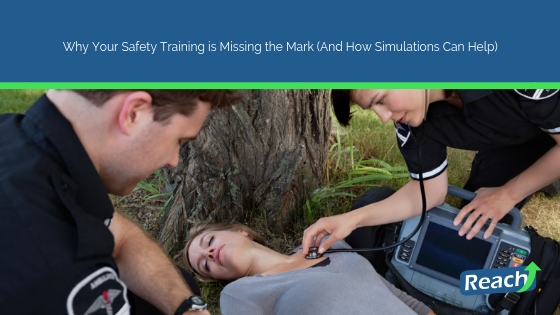Why Your Safety Training is Missing the Mark (And How Simulations Can Help)

Across a wide range of industries, health and safety training is required in order for employees to complete their jobs in a way that reduces risk.
This is extremely important, since 350 Canadians die each year from on-the-job accidents, and significantly more experience workplace injuries.
And while traditional classroom-style training methods have been relied upon across most industries, they aren’t necessarily the most effective approach when it comes to retention rates and engagement.
In fact, the average retention rate of traditional classroom training is a mere 8-10 percent – a less-than-ideal amount when you consider that health and safety training quite literally saves lives.
So, what can H&S training providers do to improve educational outcomes?
Well, there are numerous training methods that can be implemented, but one of the most convincing methods is simulation-based learning.
What is simulation-based learning?
According to the US National Library of Medicine, it is a form of experiential learning that uses the artificial representation of a real world process to achieve educational goals.
What makes simulation training the ideal learning method for health and safety curriculums?
This is the question that this blog post aims to elaborate on.
HERE ARE THREE REASONS WHY SIMULATIONS ARE IDEAL FOR HEALTH AND SAFETY TRAINING:
- THE DEVELOPMENT OF HANDS-ON SKILLS
Sure, traditional training methods that rely heavily on cognitive learning and memorization have their benefits. But when it comes to navigating your way through complex real-life scenarios where hazards and safety threats are present, employees must be able to apply the knowledge they’ve retained.
This is particularly crucial, since these scenarios often occur in high-stress environments where the health and well-being of one or more individuals are at stake.
For this reason, simulation training is highly valuable, and studies have been conducted that confirm the benefits of simulation training for emergency responders.
In fact, in one study, simulation learners’ self-efficacy (confidence) was 20 percent higher, declarative knowledge was 11 percent higher, procedural knowledge was 14 percent higher, and retention was 9 percent higher than non-interactive learners.
When you consider how fast things can change in a real-life emergency situation, these improvements in tangible, practical skills can truly mean the difference between life and death.
- HEIGHTENED ADAPTABILITY
For employees who must undergo mandatory training for hazardous situations, the ability to adapt in the moment and use their critical thinking skills on-the-fly is essential.
In one study where nursing students were questioned about the efficacy of simulation training for clinical situations, 90 percent of participants stated that simulations challenged their critical thinking and decision-making skills.
And in another study that surveyed 48 clinical nursing students, all participants agreed that “hands on practice is essential in gaining confidence and clinical reasoning skills.”
Thus, it is reasonable to conclude that educational leaders across other industries can also improve safety training with simulations, achieving more of the outcomes and objectives they set out for their trainees.
- THE POWER OF REPETITION
Unlike in classroom settings, safety training can be repeated as much as necessary when delivered via simulation, and each exercise can be tailored or altered to convey a specific educational objective.
This unique ability for employees to participate in simulation training multiple times to develop their skills and reinforce learning outcomes is highly beneficial, especially when you consider that people forget 90 percent of what they learn within three days.
Thankfully, however, repetition can improve long-term retention by as much as 200 percent.
The more times trainees are exposed to similar simulation training exercises, the more their brains become familiar with the scenarios they participate in, and the more knowledge they retain.
Eventually, with enough exposure, many hands-on skills become second nature as muscle memory heightens.
In fact, with enough repetition, the amount of effort a person expends to do a specific task can decrease by as much as 20 percent, since the mind and body become so familiar with the process.
This is extremely advantageous for employees in the health and safety industry and beyond.
How can ARC Reach help your business or organization capitalize on these benefits?
Our mobile training app can provide simulation training for your employees in a convenient, accessible, and easy-to-use platform. Contact us to book a demo.
